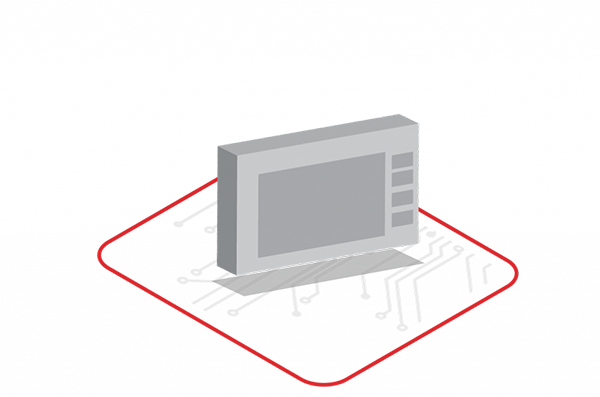HMI Solutions

HMI SOLUTIONS
Entech HMI Solutions can offer a full array of solutions for every aspect of user interaction with your equipment and the experience to help you select the best options for your application. From membrane switch assemblies, keypads and touch screen interfaces to custom fabricated control front panels to nameplates and identification labels, Entech HMI Solutions can satisfy all your equipment interface needs.
CAPABILITIES
Membrane Switches
A membrane switch is a printed electronic circuit that uses pressure to open and close a circuit. The membrane switch circuitry is most often screen printed using conductive inks, which are typically made of silver, carbon, and/or graphite. Membrane switches are part of a range of devices considered to be user interfaces (also called operator interfaces, or man-machine interfaces) along with display-based touch screens, and mechanical switches such as push-button, toggle, rocker, and slide switches. The ultimate purpose of a membrane switch is to serve as the interface between man and machine, enabling an operator to communicate with a piece of equipment, instrument, or machinery.
Membrane Switches Construction
Membrane switches are essentially a sandwich of thin layers that are bonded together using pressure sensitive adhesives. Depending on the application requirements, a membrane switch will consist of as few as 4, and as many as 9 layers. In contrast to mechanical switches, membrane switches offer the advantage of lower cost, they consume less design space with their low profile, are easy to clean, and they offer a sleeker, ergonomic, and aesthetically pleasing appearance.
The visible top layer of a membrane switch is the graphic overlay, with printed circuitry underneath the overlay. The circuitry can also incorporate different layers such as polyester (silver flex), polyimide (copper flex), and rigid PCB layers. Activation of a switch occurs when a printed shorting pad or metal dome makes contact with the bottom circuit layer thus, closing the circuit.
Resistive Touchscreens
Resistive touchscreens work on the basis of pressure applied to the screen. A resistive screen consists of a number of layers. When the screen is pressed, the outer later is pushed onto the next layer – the technology senses that pressure is being applied and registers input. Resistive touchscreens are versatile as they can be operated with a finger, a fingernail, a stylus or any other object.
Capacitive Touchscreens
Capacitive touchscreens work by sensing the conductive properties of an object, usually the skin on your fingertip. A capacitive screen on a mobile phone or smartphone usually has a glass face and doesn’t rely on pressure. This makes it more responsive than a resistive screen when it comes to gestures such as swiping and pinching. Capacitive touchscreens can only be touched with a finger, and will not respond to touches with a regular stylus, gloves or most other objects.
Captive Touch Membrane Switches
Capacitive touch membrane switches offer great design flexibility, durability, and a sleek appearance. The technology in this style membrane switches use conductive carbon printed circuitry to create an electrical field. When a human finger touches the key, an increase in the capacitance is recognized by the IC, which activates the output of the key.
Resistive Touch Membrane Switch
If you are looking for touch screen technology fully sealed to your bezel, we have the solution for you. Our Resistive Touch Screens can be bonded to a full sheet of polyester or polycarbonate overlay. This graphic overlay could also be the graphic overlay of a membrane switch layer. This design eliminates the need for clumsy perimeter gaskets or thick bezel cut outs. It provides for a washable front surface and extra durability for the touch screen in harsh environments. A full ESD shield of ITO coating or a perimeter conductive ink or foil shield layer can also be added.
Silicone Keypads
Experience our complete range of silicone keypads to suit a variety of end-user applications. Technologies available include: laser etched, multi-coloured, wear-resist coated and plastic feel keypads and keycaps. Our keypads can also incorporate a wide range of requirements in tactile feel, switch travel, endurance characteristics, aesthetic appeal, plastic keycaps and contouring. Silicone is an excellent choice for device operation controls.
- Excellent resistance to both heat and low temperature (-55°C to 250°C)
- Minimum noise generation due to soft and elastic structure
- Multi-colour designs easily accommodated
- Design both tactile and linear feedback
- Translucent materials available
- Water and contamination resistant
- Cost effective
- Minimum abrasion and high resistance to SO2 and oxidation even in heavy humidity